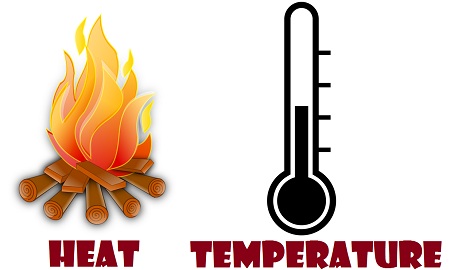Heat and temperature are related and often confused.
More heat usually means a higher temperature.
Heat (symbol: Q) is energy. It is the total
amount of energy (both kinetic and potential) possessed by the molecules in a
piece of matter. Heat is measured in Joules.
Temperature (symbol: T) is not energy. It
relates to the average (kinetic) energy of microscopic motions of a single
particle in the system per degree of freedom. It is measured in Kelvin (K),
Celsius (C) or Fahrenheit (F).
When you heat a substance, either of two
things can happen: the temperature of the substance can rise or the state of
substance can change.
|
Heat versus Temperature comparison chart
|
||
|
Heat
|
Temperature
|
|
|
Definition
|
Heat is energy that is transferred from one body
to another as the result of a difference in temperature.
|
Temperature is a measure of hotness or coldness
expressed in terms of any of several arbitrary scales like Celsius and
Fahrenheit.
|
|
Unit
|
Joules
|
Kelvin, Celsius or Fahrenheit
|
|
Symbol
|
Q
|
T
|
|
SI
unit
|
Joule
|
Kelvin
|
|
Particles
|
Heat is a measure of how many atoms there are in
a substance multiplied by how much energy each atom possesses.
|
Temperature is related to how fast the atoms
within a substance are moving. The ‘temperature’ of an object is like the
water level – it determines the direction in which ‘heat’ will flow.
|
|
Ability
to do work
|
Heat has the ability to do work.
|
Temperature can only be used to measure the
degree of heat.
|
Heat And Temperature
 Reviewed by CREATIVE SCIENCES
on
July 19, 2018
Rating:
Reviewed by CREATIVE SCIENCES
on
July 19, 2018
Rating:
 Reviewed by CREATIVE SCIENCES
on
July 19, 2018
Rating:
Reviewed by CREATIVE SCIENCES
on
July 19, 2018
Rating:





